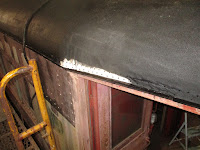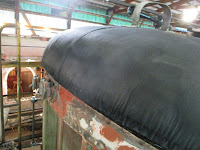Monday was another productive day at the old carbarn. I'll tell you more about the 306 later. Meanwhile, I started by installing some more screws to hold down the trolley boards, but that's not very photogenic. I then modified the shims as needed and managed to attach both horns in a permanent fashion. So that's a good step forward.
News and views of progress at the Illinois Railway Museum
Tuesday, April 27, 2021
Shrink-wrapped to Preserve Freshness
Posted by
Randall Hicks
at
9:00 AM
0
comments
![]()
Labels: 453 Progress
Monday, April 26, 2021
Light up
Frank writes...
Another exciting thing knocked off the to-do list was testing and electrification of the sign light circuit. There are five bulbs in this circuit (natch), three in the front box and one in each of the two side boxes. Thanks to Joel and Richard, who helped procure a couple of replacement bulbs that were needed. And of course a huge thank you to Bill Wulfert, who did all of the work of rebuilding and repainting the inside of the front sign box and also did quite a lot of restoration work on the front roll sign itself, including installing new leaders. Thanks, Bill!!
As always, there was plenty of activity. Jack and new volunteer Mike were working on inspecting the Matchbox and they got this job done by the end of the day. Joel was sorting parts and Nick and Greg were out on the railroad doing DC Line Department stuff. Thomas and Ashton, and I think Richard, were working on 'L' car stuff. Zach was in train service; it seemed like we had another good crowd so a second two-car electric train was brought out. The 251's journal bearing so far seems to be doing okay so that car is now back in revenue service.
Late in the afternoon I did some railfanning around the property. This is the new switch #711 at the south end of the wye, completely replaced by our volunteer Track Department over the course of just eight days. What a job!
It was pointed out that this is the newest rail on the property, dating to 2019. It's still grey from the mill.
And here's something you'll have to check out for yourself on your next visit. I stopped by Barn 3, where the IC side-door caboose and the FGEX reefer have now been opened to the public as part of the freight train exhibit. Both are very impressive, particularly the reefer, whose varnished interior is really pretty striking. The lighting and exhibit boards look extremely professional and the "props" are a great addition. I get the impression that more artifacts are likely to be added over time. What's shown here, at one end of the car, is a selection of ice-cutting tools as part of an explanation of how ice (for use in reefers like this one) was sourced. The other end of the car has a lot more information about reefers and the meat-packing industry in general. It's terrific stuff and really raises the bar for our educational efforts, I think. Kudos to the folks who have been working on this exhibit.
Posted by
Frank Hicks
at
8:16 AM
1 comments
![]()
Labels: 18 Progress
Friday, April 23, 2021
Thursday Report
For Thursday, another exciting day at IRM brings us a few pictures of progress.
First, we'll take a look at the rapid progress by the Track Dept. in replacing the south wye switch. The old switch was removed in two sections and placed on track carts. Here's one of them:
And as usual, there were other things going on, but I didn't get pictures of them.
Posted by
Randall Hicks
at
7:52 AM
0
comments
![]()
Labels: 453 Progress
Wednesday, April 21, 2021
New Store in Town
There's a new store in town, and the proprietor asked us for some free publicity. We don't do this for just anybody, but he's an old friend, and we want to keep it that way, so....
Your model train dollars will go farther at Union Hobby Shop!
Posted by
Randall Hicks
at
4:43 PM
1 comments
![]()
Labels: Building and Grounds
Tuesday, April 20, 2021
Tuesday Progress
Another day, another several steps forward:
On the 453, I did some more work on fastening down the running boards. And then, we're ready to start attaching drip rails and ventilators, with a good supply of new screws, as well as caulk. On these cars, they used a lot more screws than I would have thought necessary, so it takes a while to install these parts. Here's a drip rail:
And then, as I think about it, Pete Galayda was working on the 160, and Tim Peters was working on 50th Avenue, and Gregg Wolfersheim was working on the M-35, but I didn't get any pictures of them. One can't be everywhere at once.
Posted by
Randall Hicks
at
8:49 AM
0
comments
![]()
Labels: 453 Progress
Monday, April 19, 2021
Sunday update
Frank writes...
Nick E was in train service during the day while Greg was working with our indefatigable Track Department on a complete replacement of the south wye switch, the one right in front of the Central Avenue platform. I failed to get a photo of this work, but never fear, our intrepid unpaid staff photographer Bill Wulfert has sent in a picture of the progress.
Posted by
Frank Hicks
at
3:54 PM
0
comments
![]()
Labels: 18 Progress




















































